#tom powel imaging
Photo

Roni Horn, Remembered Words – Poconos, (gouache, watercolor, graphite, Japan color, and gum arabic on paper), 2012-2013 [Kukje Gallery, Seoul. © Roni Horn. Photo: © Tom Powel Imaging]
#art#drawing#visual writing#geometry#pattern#grid#gouache#roni horn#kukje gallery#tom powel imaging#2010s
81 notes
·
View notes
Text





“Making Their Mark,” presented by the Shah Garg Foundation and curated by Cecilia Alemani, is a monumental exhibition featuring 80 significant women artists from the last 80 years. Among these notable women are #MTAarts artists Firelei Báez, Faith Ringgold, Sarah Sze, and Elizabeth Murray.
On view in Chelsea through Mar 23, the exhibition “champions the lives and work of women artists, bringing into vibrant relief their intergenerational relationships, formal and material breakthroughs, and historical impact. Through drawings, mixed media works, paintings, sculptures, and textile works, the artists of ‘Making Their Mark’ rechart art history through their singular, iconic practices.” - Shah Garg Foundation
Images
1: Firelei Baez, “Ciguapa Antellana, me llamo sueño de la madrugada (who more sci-fi than us)” (2018) at 163 St-Amsterdam Av (C) station. 📸: Osheen Haruthoonyan
2: Faith Ringgold, “Flying Home: Harlem Heroes and Heroines (Downtown and Uptown)” (1996) at 125 St (2,3) station. 📸: Trent Reeves
3: Sarah Sze, “Blueprint for a Landscape” (2017) at 96 St (Q) station. 📸: Tom Powel
4: Elizabeth Murray, “Blooming” (1996) by Elizabeth Murray at 59 St/Lexington Av-59 St (N,R,W) station. 📸: MTA A&D/Rob Wilson
5: Elizabeth Murray, “Stream” (2001) at Court Sq (E,M,G,7) station. 📸: MTA A&D Rob Wilson
21 notes
·
View notes
Text
Peeping Tom (1960)

I’ve seen Michael Powell’s Peeping Tom on several lists of “the best slasher movies ever made”. I don’t know if it belongs among the likes of Halloween or The Burning. Not because it isn’t good. Quite the opposite; this is an excellent film. I’m saying it doesn’t belong because this isn’t really a slasher film. This psychological horror-thriller doesn’t have the masked killed, the character “in the know” or many of the other tropes you’d expect to see. Instead, it has the transitional elements that would someday become them. Semantics aside, this film stands confidently as a piece of horror history or on its own.
In London, Mark Lewis (Carl Boehm) is a photographer and aspiring filmmaker obsessed with capturing images of fear. Alone in his loft, he watches videos of the murders he's committed. As the investigators on his tail begin getting closer, he befriends Helen Stephens (Anna Massey).
It would be interesting to see Peeping Tom remade because so many aspects of it would be different if shot today. In 1960, cameras weren’t rare but they weren’t everpresent the way they are today and you could argue that we’ve become as obsessed with photography and videos as Mark. He isn’t merely shooting the last moments of his victim’s lives; he goes back to the scene of the crime the next morning to capture the looks on people’s faces when they wheel out the prostitute he murdered (Brenda Bruce). He wants to see how people react when they find the bodies. He wants to see the moment when his victims realize their lives are over again and again. Whenever he meets a woman and shows the slightest bit of interest in her, you wonder what he sees. Another victim? A kindred spirit? To a man this unhinged, is there a difference?
The thing is that Mark isn’t completely loony. Most of the time, he seems like a perfectly normal person. Perhaps a bit shy, but he has a normal job, the scenes with him and Helen are even a bit sweet - though they can make the middle feel a tad slow. You’d never guess just how disturbed he is under that facade, which makes him much scarier than someone like Jason Voorhees. This is the kind of character any psychologist would have a field day evaluating because each scene unveils a new layer of psychological complexity.
For the titular peeping tom alone, this is a great film but there are other elements to appreciate. The very first shot is from Mark’s point of view. It’s not because we’re going to have a twist reveal of his identity later; it’s so we can feel what it’s like to be him. We never see the actual murders - the camera always cuts away. This means we eagerly anticipate the scenes where Mark sits down to watch his snuff films - even if the scene just happened. Like him, we’re hoping to catch something we didn’t the first time. Every time, his reels fail to deliver what we want. It makes us look forward to the next crime. “This time, for sure” the film seems to say. For 101 minutes, we're addicts and that ending? It’s quite a shocker. You should’ve seen coming but didn’t, which makes it that much more unsettling.
Like so many horror classics before it, Peeping Tom was practically burned at the stake upon its initial release. In a way, you can sort of understand why. Even today, Mark Lewis makes your skin crawl and the idea that a “good movie” has to be “good for you” still prevails. The outrage made everyone miss the excellent storytelling and characterization at the core of Peeping Tom. This is a picture I see myself returning to, and appreciating more with every subsequent watch. (May 13, 2022)

#Peeping Tom#movies#films#movie reviews#film reviews#Michael Powell#Leo Marks#Carl Boehm#Moira Shearer#Anna Massey#Maxine Audley#1960 movies#1960 films
2 notes
·
View notes
Text

Well, we're almost at the halfway point for the event. This month is going fast!
The event is open to everyone - artists, authors, gif/image/video editors, and even followers!
Readers and admirers spread some love and show support for your favorite creatives. Reblog and comment on a post (old or new) with a Christmas-related theme that includes one of the characters below. Then submit the link to your reblog and earn an entry for the prize drawing. Easy-peasy!
There are lots of characters and fandoms to choose from.
Characters:
Jensen Ackles~Dean Winchester~Soldier Boy~Beau Arlen
Ben Barnes~General Kirigan(The Darkling)~Billy Russo(Jigsaw)~Logan Delos
Sam Claflin~Billy Dunne (Daisy Jones & The Six)
Tom Ellis~Lucifer Morningstar
Chris Evans~Steve Rogers~Captain America~Andy Barber~Ari Levison
Charlie Hunnam~Jax Teller~Raleigh Becket
Christian Kane~Eliot Spencer~Jacob Stone~Lindsey McDonald~Leo Webb
Joel Kinnaman~Col. Rick Flag~Erik Heller~Takeshi Kovacs
Jeffrey Dean Morgan~Negan~Denny Duequette~JD Richter~Jason Crouse
Timothy Olyphant~Raylan Givens~Agent 47~Seth Bullock~Cobb Vanth
Glen Powell~Jake Seresin
Keanu Reeves~John Wick~Neo~John Constantine
Sebastian Stan~Bucky Barnes~TWS~Nick Fowler~Max(Sharper)
Karl Urban~Billy Butcher~Leonard McCoy~Black Hat~Woodrow F. Call
Learn more about the TGWRC Christmas in July Event.
6 notes
·
View notes
Text
The ways in which ideas about ‘Zomia’ have provoked, inspired, jostled and indeed riled are certainly intriguing. [...] A G[oo]gle search for the term ‘Zomia’ yields 90,700 results (as of [2019]) [...]. Among these, [...] in an opinion piece [...] titled “The Undiscovered Country” (14 Feb 2012), Frank Jacobs [...] offered up a short history of ‘refuges, sanctuaries, freetowns, zones of no control’, adding [...] ‘Zomia’ to this mix. [...] Jacobs suggested that,
there exists another type of border, one that doesn’t reflect back our image. In vampiric asymmetry [...]. The world as we know it -- reciprocal even across national borders -- ends here. [...] The borderline does not merely separate two territories, but two paradigms: law and order from anarchy, progress from primitivism. Or perhaps, seen from the other side: freedom from oppression [...].
In Germany, a caravan park calling itself “Wagenplatz Zomia” has also drawn inspiration [...] as the community protests against high rents in Hamburg [...]. [C]ommunity members face eviction from [...] hostile and inept municipalities that spend millions of Euros building commercial centres that end up derelict and empty [...]. The authorities are also seen as utterly resistant to providing affordable housing for low income residents. Here, Zomia encapsulates protest against the state, represented by the neo-liberal economic vision of progress.
Generally speaking, the debate generated, particularly by Scott’s emphasis on Zomia as an intentional ‘non-state’ space, has been significant [...], and it continues to unfold in surprising ways. [...]
---
On the other hand, scholars not necessarily working in highland Asia but inspired by the emphasis on indigenous agency, namely that communities ‘chose to place themselves out of the reach of the state’ [...], have found ways to incorporate these ideas in their own research. [...] Benjamin Powell and Malvika Nair (2012), for example, have incorporated many of these ideas while engaging in comparative studies between a 19th century South Indian banking caste and modern day Somalia. Thus, as a ‘heuristic of resistance’, Zomia has stimulated considerations of applicability [...]. Perhaps the best example is Caroline Humphrey’s exploration of Zomia as an idea in Inner Asian studies. She wrote (2015: 105):
Thinking in terms of Zomia allows a looking outwards from peripheral areas as at the impositions of states and empires. It becomes clear that the ‘friction of terrain’, the very difficulty or remoteness of these zones, has given an advantage to the [...] inhabitants, who know the local passageways, the hideouts, the hidden desert wells, as so forth [...], while at the same time rendering tax collection, military conscription, etc. [...] difficult enough [...] for a pre-modern state apparatus. [...] Zomia-like areas could maintain a certain independence [...]. [T]heir relative inaccessibility was the very reason why these zones became refuges for repeated waves of runaways, migrants, deserters and bandits, and also, in some cases, sites of millenarian resistance to colonialism. [...]
---
Tom Brass, in his piece “Scott’s “Zomia”, or a Populist Postmodern History of Nowhere,” (2012: 125) suggested that Scott’s Zomia project [...] follows a trend of ‘resurgent populist historiography’ that orientalises the agency of people living at the margins, a trend that has ‘colonised academic journals’ [...].
Hjorleifur Jonsson (2014, 2010) similarly sees Scott and many of his followers as failing to recognise how the notion of everyday resistance as a kind of cultural trait essentialises a great multitude of complex peoples that are anything but the nostalgic anthropologist’s ‘pure’ and ‘unpolluted’ small-scale societies. [...] Sanford Schram, on the other hand, has suggested that the myriad forms that resistance and evasion from state interference engendered in Scott’s account point to a very important, context-specific insight, thus, on those grounds alone, meriting further exploration [...]. Unsurprisingly, in an age of increasingly authoritarian regimes, unfettered global capitalism, and [...] state and private surveillance, the idea of a large swath of Asia existing beyond state control [...] is very attractive.
Critics have been clear about the fact that we mustn’t essentialise this space. [...]
---
Text by: Arkotong Longkumer and Michael Heneise. “The Highlander.” The Highlander: Journal of Highland Asia. Volume 1, no. 1. December 2019. [Bold emphasis, italics, and some paragraph breaks added by me.]
13 notes
·
View notes
Text
picture me in my black denim tom of finland jacket running around downtown portland at 9pm trying to find my car (because what the fuck do i know about west of the river) while clutching a paperback copy of leslie feinberg's trans liberation that i just bought at powell's for $8 ten minutes before they closed... girl THAT'S the blatant lesbian image
4 notes
·
View notes
Text
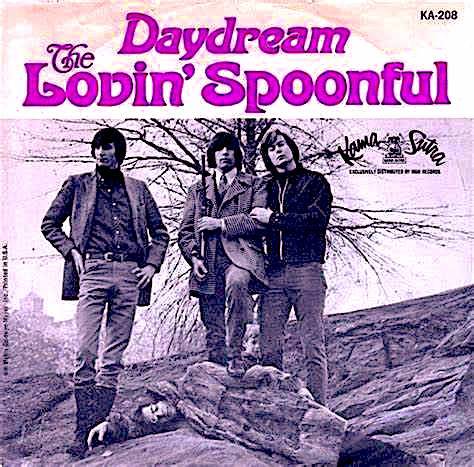
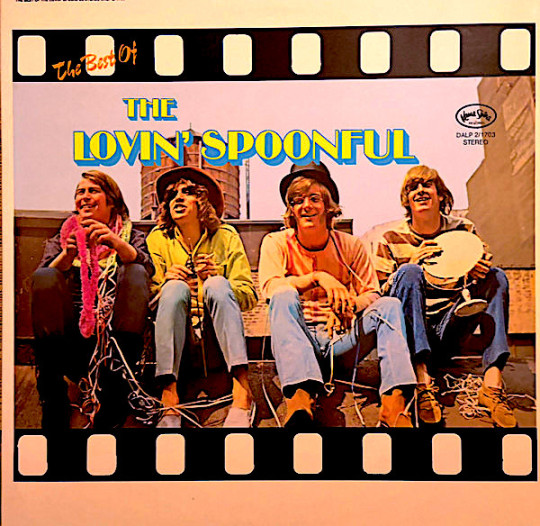
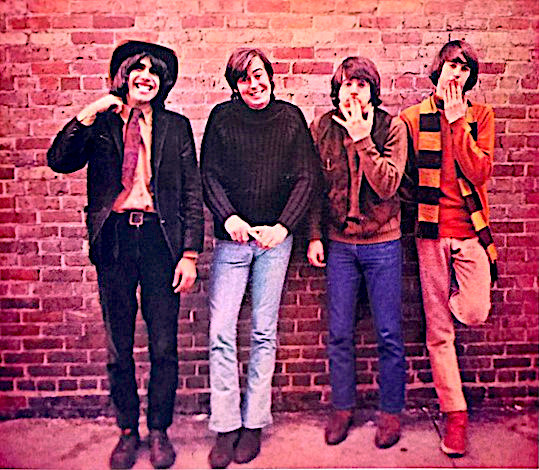


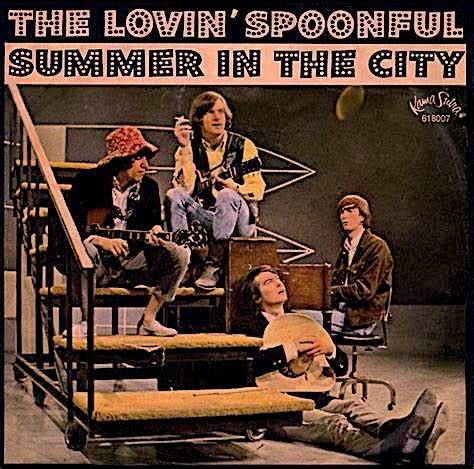
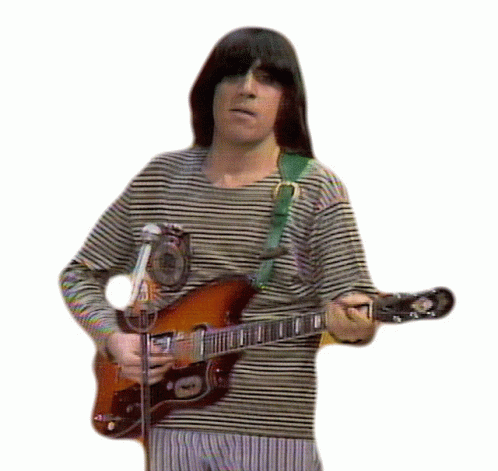

HAPPY BIRTHDAY to my friend and keyboardist Steve Adams, Roy Buchanan, Ray Charles, John Coltrane, Danielle Dax, Ani DiFranco, Jermaine Dupri, Charles M. Gehr, Don Grolnick, Buddy Holly’s 1957 single “That’ll be the Day,” Julio Iglesias, Cush Jumbo, Tim Keller, Tom Lester (“Eb”), John Lomax, the discovery of Neptune (1846), OMC, Paul Petersen, Walter Pidgeon, Mary Kay Place, Aubrey “ Po” Powell (Hipgnosis), Mickey Rooney (good to have met you), Tim Rose, Romy Schneider, the 1994 film SHAWSHANK REDEMPTION, the late Rolf Smedvig (good to have met you), Neil Smith (Alice Cooper), Bruce Springsteen, Jeremy Steig, Soulima Stravinsky, and Steve Boone of The Lovin’ Spoonful. Starting in 1964, The Lovin’ Spoonful rose out of the Greenwich Village folk/jug band scene. Their sound diversified into chamber pop (“She’s Still a Mystery”), country rock (“Nashville Cats”), and the chart-topping hard-edged psychedelic “Summer in the City”—songs penned by their main songwriter, John Sebastian (who later embarked on a long and notable solo career). Beginning in July 1965 with their debut single “Do You Believe in Magic,” the band had 7 consecutive singles reach the Top 10, including “Daydream,” “Did You Ever Have to Make Up Your Mind?” and “Rain on the Roof.” By the mid-60s, The Spoonful was among the most popular groups in the world, and their music and image influenced many rock acts of their era—it is believed that John Sebastian’s wearing of “granny glasses” inspired John Lennon to follow suit. The band migrated from NYC to the Laurel Canyon (Los Angeles) music scene, intersecting with Crosby Stills & Nash, Love, The Mamas & Papas, The Monkees, Frank Zappa, etc. After 1967, The Spoonful went through various line-ups (including a short reformation in the 1979 Paul Simon film ONE TRICK PONY). The current iteration features Steve and long-time members Joe Butler and Mike Arturi. We crossed paths on road gigs a few times—check out this recent clip https://www.youtube.com/watch?v=isTJ3VBL18Q Meanwhile, HB SB and thank you for your years of giving us lovin’ spoonfuls of great and joyful music (photo of the band at a brick wall by Henry Diltz).
#lovinspoonful #steveboone #johnsebastian #joebutler #mikearturi #birthday #johnnyjblair #wildhoney #henrydiltz
#johnny j blair#music#pop rock#monkees#Lovin Spoonful#Steve Boone#John Sebastian#Mike Arturi#birthday#Henry Diltz
3 notes
·
View notes
Photo

Roni Horn, Remembered Words – Meat Puppet, (watercolor, graphite, and gum arabic on paper), 2012-2013 [Kukje Gallery, Seoul. © Roni Horn. Photo: © Tom Powel Imaging]
44 notes
·
View notes
Text
Big Pokey Wiki – Milton Powell by the stage name Big Pokey was 45 years old and an American rapper from Houston, Texas. Big Pokey was associated with chopped and screwed up music and was one of the original members of Screwed Up Click. Big Pokey began rapping with Houston producer DJ Screw in the early 1990s and has released songs on many of DJ Screw’s mixtapes. Big Pokey was featured on DJ Screw’s “27 June Freestyle” mixtape, which became a landmark album in diced and screwed hip hop.

His first full-length album, Hardest Pit in the Litter, was released in early 1999. The following year, Pokey returned with another album, D-Game 2000, consisting of 808 mid-tempo guided beats, featuring several of his Houston colleagues. He collaborated with Wreckshop Wolfpack for Tha Collabo in 2001 and then returned in 2002 with another solo album, Da Sky’s Da Limit. In 2004, a clip of Pokey’s song “Who Dat Talkin Down” appeared in the pilot episode of HBO’s Entourage. In 2005, Pokey appeared on Paul Wall’s track “Sittin’ Sidewayz”, which peaked at #93 on the US Billboard Hot 100. The single remains Pokey’s top single on the charts.
youtube
Big Pokey’s Age
Big Pokey was 45 year old
Houston-born rapper Big Pokey, whose real name is Milton Powell, has been confirmed to have died at the age of 45.
According to reports, the rapper allegedly fell to the ground during a performance in Texas on Saturday and his death was confirmed by Justice of Justice Tom Gillam III.
CBS affiliate KFDM reported: “Justice of Peace Tom Gillam III has confirmed that Houston Rapper Milton Powell, better known as Big Pokey, has passed away at St. Elizabeth Hospital.”
They stated that his death came after he “fainted” at the Pour 09 Bar in Beaumont on Saturday night. They added that the cause of death is awaiting an autopsy.
youtube
A video was shared on social media showing Big Pokey crashing. The footage shows people rushing to the rapper.
While the US Sun reported that a second clip shared online showed people performing CPR on the musician.
Many social media users are uncomfortable with the sharing of disturbing images on the internet.
Big Pokey is best known for being an original member of the hip-hop group Screwed Up Click.
His work was not limited to music, he even acted in films. He starred in Soldiers United for Cash in 2001 and later appeared in Dirty Third 2: Home Sweet Home.
Tributes flock to the rapper as his fans and fellow musicians quickly pay their respects.
Pokey’s close friend, Port Arthur Native Bun B, shared a touching tribute on Instagram.
He wrote: “I wasn’t ready for this. One of the most naturally gifted artists in the city. The plain, humble mountain of a man who acts with dignity and respect. Easy to love, hard to hate …”
As one fan tweeted: “Sad day for Houston…..Tear the big poke……Texas legend forever.”
3 notes
·
View notes
Text

someone used this pic of glen powell as a reaction image on a sexy pic of tom cruise which is the only correct way to use it i think
8 notes
·
View notes
Text

Patrouille de France pays tribute to Tom Cruise at the premiere of "Top Gun: Maverick" in Cannes
Fernando Valduga By Fernando Valduga 05/19/22 - 06:00 AM in Demonstration Squadrons, Military
Tom Cruise is in France for the premiere of the film "Top Gun: Maverick" at the Cannes Film Festival. He took the opportunity to visit the headquarters of the Patrouille de France and received a beautiful tribute from the demonstration squadron of the French Air and Space Force. Check out the images.

Patrouille de France paid tribute to Tom Cruise and his character Pete "Maverick" Mitchell. (Photo: Geyres Christophe/ ABACAPRESS.COM)
The actor who plays Captain Pete "Maverick" Mitchell in the feature film also took the opportunity to meet Patrouille de France on Tuesday to talk about "cinema and especially aviation," witnessed Captain Grégory, pilot of the French squadron.

The Patrouille de France above the Palais des Festivals, during the climb of the steps of Tom Cruise and the team of "Top Gun: Maverick". (Photo: Daniel Cole/AP/SIPA)
"He inspired a generation of pilots," the patrol wrote on his Twitter account, accompanied by photos of the star, all smiling, aboard an Alpha jet and next to the pilots.

Tom Cruise's visit to Cannes, after a 30-year absence, was definitely Wednesday's main event. Tom Cruise climbed the steps of the Cannes Film Festival on the opening night of the film "Top Gun Maverick", shown out of competition.

The team of the movie "Top Gun: Maverick" did not miss any details of the Patrouille de France tickets. (Photo: Petros Giannakouris/AP/SIPA)

The Patrouille de France above the Palais des Festivals, during the climb of the steps of Tom Cruise and the team of "Top Gun: Maverick". (Photo: VALERY HACHE/AFP)
To welcome Pete "Maverick" Mitchell's return to business, the Patrouille de France passed twice in the Cannes sky, above the red carpet, leaving the team enthusiastic about the passages of the Alpha Jets jets.

Tom Cruise was also surprised by the honorary Palme d'Or of the festival.
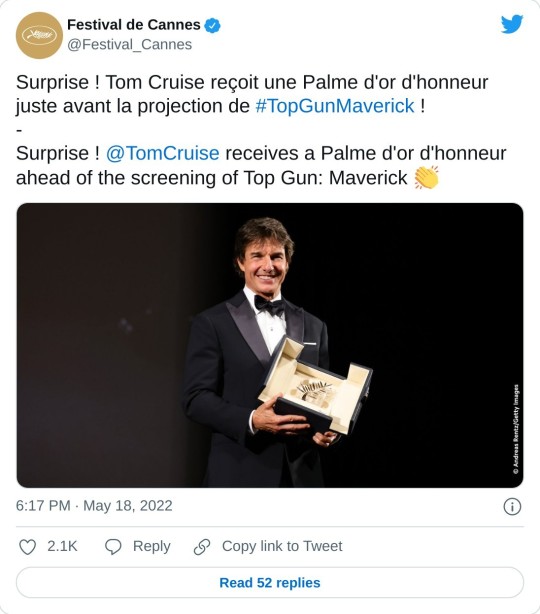
After a very remarkable arrival by helicopter in the afternoon, the festivities did not stop there. The Patrouille de France paid tribute to the actor by climbing the steps, leaving a blue-white-red trail in the sky. A passage much appreciated by the entire cast, producer and director of the film "Top Gun: Maverick".

The Alpha Jets, based not far away, at 701 Air Base in Salon-de-Provence, enchanted the cast of the film, including Jennifer Connelly, Miles Teller and Glen Powell, who savored the show with the same admiration.

Top Gun: Maverick, the long-awaited sequel to the 80s cult film, is scheduled to premiere on May 26.
Patrouille de France made two passages through the most envied red carpet of the moment. (Photo: Geyres Christophe / ABACAPRESS.COM)
Tags: Military AviationDemonstration SquadronsPatrouille de FranceTop Gun: Maverick
Fernando Valduga
Aviation photographer and pilot since 1992, he has participated in several events and air operations, such as Cruzex, AirVenture, Dayton Airshow and FIDAE. He has works published in a specialized aviation magazine in Brazil and abroad. He uses Canon equipment during his photographic work in the world of aviation
HOME Main Page Editorials Information Events Collaborate SPECIALS Advertise About
Cavok Brasil - Digital Tchê Web Creation
1 note
·
View note
Text
Meet the People

Charles Reisner’s MEET THE PEOPLE (1944, TCM) was an important film for Dick Powell, if not for anyone else besides June Allyson. It’s the film on which they met (and if you see June’s number, “I Like to Recognize the Tune,” you’ll imagine Joan Blondell standing and cheering at the button), and it was his final turn as a boy singer before he changed his image in MURDER, MY SWEET (1944). He seems to be marking time here, which isn’t very fair to leading lady Lucille Ball, who pretty much has to carry their scenes. Like most of MGM’s lesser musicals, it has a negligible plot (playwriting welder Powell dares Broadway star Ball to get to know real people before he’ll let her star in his play) that ties together comic bits — some good, some unbearable — and musical numbers — ditto. There are too many minuses to list, so let’s concentrate on the positives. Ball is charming in a love scene when she talks about working her way up from the chorus. Bert Lahr has some funny bits and a cute song about sailing before he vanishes for no discernible reason. Also funny is Rags Ragland as a house husband saddled with two unbearable children (one of whom is Robert Blake). Allyson’s number may be one of Rodgers and Hart’s most forgettable songs, but it’s arranged wittily by Kay Thompson, who could do no wrong (and probably enjoyed the button, too). Spike Jones and his City Slickers have a funny routine with Cheetah from the Tarzan films playing Hitler and a musical segue into the sextette from LUCIA DI LAMMERMOOR. And Virginia O’Brien gets to do “Say We’re Sweethearts Again,” the greatest tribute to masochism until Tom Lehrer came along. Frankly, they should have jettisoned the plot and just done 90 minutes of Jones and O’Brien.
#movie musicals#dick powell#lucille ball#june allyson#kay thompson#virginia o'brien#spike jones#bert lahr#rags ragland#robert blake
0 notes
Text
Venezia, Biennale Arte 2024: Robert Indiana "The Sweet Mystery" alle Procuratie Vecchie
Robert Indiana: Exploding Numbers, 1964–66, Oil on canvas. Four panels: 1: 12 × 12 in. (30.5 × 30.5 cm) 2: 24 × 24 in. (61 × 61 cm) 3: 36 × 36 in. (91.4 × 91.4 cm) 4: 48 × 48 in. (121.9 × 121.9 cm) Photo: Courtesy of Tom Powel Imaging, New York; Artwork© 2024 Morgan Art Foundation Ltd./ Artists Rights Society (ARS), NYCourtesy The Robert Indiana Legacy Initiative
ROBERT INDIANA: THE SWEET…

View On WordPress
0 notes
Text
Rustin

Awards buzz first thrust George C. Wolfe’s biopic about U.S. civil rights activist Bayard Rustin, the openly homosexual (largely use this word and "gay" as the then common "labels") African American architect of the landmark 1963 March On Washington, onto my radar. What’s not to like, right? and onto my (Netflix) watchlist it went.
Plopping up after another biopic, the beautifully mounted but ultimately hollow Maestro, Rustin might have benefitted from a favorable comparison – both films examine the lives of queer men who in one way or another strived for social change in postwar America – not that Maestro even mentions Leonard Bernstein’s philanthropy and support of progressive causes like the Black Panthers, even if Tom Wolfe coined the term “radical chic” to question the sincerity of celebrity political activism, after attending a Bernstein benefit for the Panthers .
youtube
Thanks to Netflix’s algorithms and playback mode, the final strains of music from “Candide” accompanying Maestro’s end credits briskly segued into Branford Marsalis’ jazzy Rustin score. The film begins with onscreen text informing us that discrimination based upon race was declared unconstitional by the U.S. Supreme Court in 1953. This is followed by wordless horrific images of the humiliation African Americans (here primarily young women) had to endure from whites (largely male with the occasional hateful looking woman) when exercising their constitutional right to attend school. After the film’s title appears briefly, we hear offscreen “things have to change and they need to change now.” It’s 1960 and we witness various civil rights activists, including Martin Luther King (Aml Ameen) and Bayard Rustin (Colman Domingo), planning a non-violent demonstration at the Democratic Convention that summer. Threats of Gandhi-inspired civil disobedience in the 1940s successfully pressured the Roosevelt Administration into ending discrimination in the military and defense industries, so why not use this method again? Yet not all African American leaders are down: NAACP (National Association for the Advancement of Colored People) head Roy Wilkins (Chris Rock in an unusual serious role) thinks the movement should tread even more lightly to achieve its goals. Longtime Democratic New York City Congressman Adam Clayton Powell, Jr. (Jeffrey Wright), on the other hand, seems primarily angry about a movement he doesn’t control and worried about how a protest might affect his standing within the party. Clayton Powell leans on King to drop the idea and Rustin, too, while he’s at it, otherwise there will be rumors about just how tight King and his charismatic and effective advisor really are. The protest is called off; King reluctantly dumps his friend.
(The Obamas’ company Higher Ground executive produced the film; did Barack Obama think about his former pastor, Reverend Jeremiah Wright, with whom he severed ties during his first campaign after Wright spouted antisemitic statements and conspiracy theories? While, unlike the smear campaign against Rustin, Obama’s rupture with Wright was understandable, it might have caused considerable soul searching. Wright later somewhat toned down his rhetoric.)

Rustin finds himself in the political wilderness, living in New York, taking a unfulfilling job with a lefty nuclear disarmament NGO – an all-white joint with, as it turns out, a homophobic boss who claims he just wants to keep Rustin on the straight and narrow. Rustin enjoys the company of a younger white man - smart, sweet, devoted (at times to a fault) Tom Kahn (Gus Halper) and has a support system of accepting friends.
Soon, it’s 1963, and President Kennedy holds a televised speech promising further civil rights legislation. This is received with skepticism (civil rights were apparently not Kennedy’s top priority) which turns into outrage when that evening, images of particularly brutal police retaliation against demonstrators, including hosing down children, appear on TV. “Things have to change,” and this time, Rustin is determined to make that happen. He reaches out to labor activist (head of the Brotherhood of Sleeping Car Porters) A. Philip Randolph (Glynn Thurman) and floats the idea of a massive non-violent march, for “jobs and freedom,” on Washington. Randolph is game. Rustin and King reconcile. And so, with Randolph nominally the chief organizer and Rustin running the show in the background, they set out to recruit the other “Big Six” civil rights organizations (in addition to the Brotherhood the NAACP, SNCC - Student Nonviolent Coordinating Committee, CORE - Congress On Racial Equality, King’s Southern Christian Leadership Conference and the National Urban League) while Rustin sets up a tight logistics operation.

Rustin doesn’t always successfully avoid sentimental biopic clichés, but the film crackles with comic energy when it shows how the dedicated team, under Rustin, both drill sergeant and seducer, manages the nuts and bolts of organizing the march. How many narrative films walk audiences through political grunt work? - from first brainstorming sessions, fundraising for busses to bring demonstrators from around the country to and from Washington to securing food supplies (peanut butter and jelly trumps cheese sandwiches) and Rustin’s contrasting security meetings with the African American brotherhood within NYPD (open to non-violent, de-escalation tactics) and the all-white D.C. police force delegation (latently racist, overstepping boundaries, possibly in cahoots with the F.B.I.). One especially satisfying moment: Rustin, again under pressure and somewhat out of commission, gazes appreciatively at his team as they have become so self-motivated and professional that the well-oiled machine can practically run without him.
Before the big day rolls around, the NAACP still is hesitant unless compromises are made. One: no White House, the protest stays at the Mall (one of the funniest exchanges during the prep sequence shows Rustin asking how many people are needed to surround the White House – a volunteer thinks this is a joke set up before he conveys she better get right on this). And two: the event is shortened from two days to one – considering the messy logistics of tent accommodation and longer leaves of absence from work, maybe Wilkins was being sensible here?
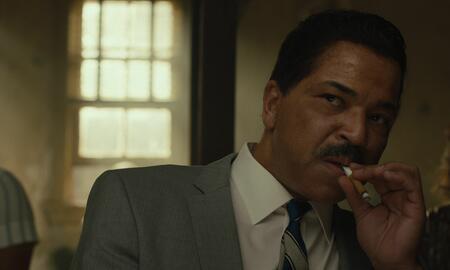
Just when the NAACP is finally on board, Clayton Powell throws a another spanner into the works: again he blackmails the group with Rustin’s long severed Communist Party ties and a 10-year-old rap sheet for lewd conduct with two (adult) men. Wright plays Clayton Powell as a full-fledged villain, jealous of King’s power base in the South and defending tooth and nail his own in New York and D.C. His torpedoing of the 1960 protest is of public record, but didn’t find any mention of his backstabbing in 1963. On the contrary, while Clayton Powell’s long career ended amidst corruption scandals and he was always considered rather self-serving, he is credited for moving civil rights legislation forward and serving his Harlem constituency. This is one instance of the film playing somewhat fast and loose with facts – or fudging them into confusion.

Fortunately, this time, Clayton Powell’s blackmail attempt is thwarted and everyone rallies around Rustin as the guiding force of the march. The big day, August 28, 1963, comes. At first, local police estimates a crowd of 75 before the masses flood the Mall. Martin Luther King holds his legendary “I Have A Dream” speech before 250,000-300,000 people. It was the largest peaceful protest to date. Afterwards, the White House invites reps of the “Big 10” organizations (somewhat confusingly, the film earlier stated that the “Big Six” had mushroomed due to the participation of more unions, but historical records generally speak about the “Big Six”). Rustin contentedly stays in the background, helping to clean up the Mall.
After a final montage which somewhat awkwardly blends archive and staged footage, the standard biopic wrap-up titles add that comprehensive civil rights legislation was passed and signed into law in 1964 (by Kennedy’s successor Lyndon Johnson, a Texas Dixiecrat – conservative Southern Democrat – who nevertheless became more committed to civil rights than his slain predecessor was). That same year, King was awarded a Nobel Peace Prize. Rustin continued his advocacy work and in 1977 met his longtime companion with whom he remained together until Rustin’s death in 1987. In 2013, 50 years after the march, President Obama post-humously awarded the Presidential Medal of Freedom to Rustin.
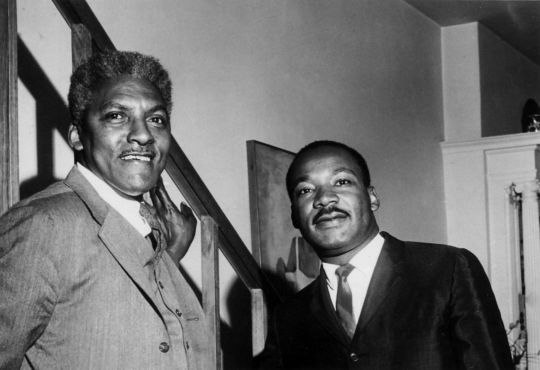
The titles don’t mention King’s increasingly vocal opposition to the Vietnam War and stronger demands for economic equality. And while King became somewhat more radical in the months before his asassination, Rustin was criticized for allegedly “selling out.” This meant cosying up to the Democratic party und big unions like the AFL-CIO, eschewing Black Power politics and later affirmative action (Rustin thought any form of “identity politics” was counterproductive as it could alienate necessary white allies) and adopting an anti-communist/anti-Soviet stance through his conditional support of the war (rollback of communism - yes, punitive military action against Vietnamese civilians - no). Contrary to his anti-communism, Rustin remained a lifelong socialist through his advocacy of social justice by wealth redistribution. And he was a gay rights activist until the end.

This aspect of Rustin’s life is brought to life through Colman Domingo’s compelling performance. He portrays Rustin as a self-confident, sexually attractive man who defies the homophobia of his era without ever becoming a victim. Rustin’s two key relationships, on the other hand, are not fleshed out. Tom stands by his man with little complaint when Rustin’s flirtations with other men become intense (Rustin admonishes Tom not to act like “Mrs. Rustin”). Tom is a more doormat-like version of Scott Smith (played by James Franco), the similarly long-suffering boyfriend of gay activist and later politician Harvey Milk in Gus Van Sant’s Milk – the screenplays for both films were written or co-written by Dustin Lance Black. As indicated in the film, when Rustin tells Tom he can’t allow himself to fall in love, but Tom will always be his family, the real-life Rustin and Tom Kahn remained friends and even co-authored an article about evolving protest into party politics. Rustin’s second significant relationship in the film was with the fictional Elias Taylor (Johnny Ramey), a NAACP lieutenant and married clergyman, groomed to take over his father-in-law’s congregation. After Elias helps to shoot down Rustin’s suggested march (the soon-to-be KKK murder victim Medger Evans is the only NAACP member who gets and supports it), he approaches Rustin in the men’s room. Elias flirts rather unabashedly; the two convene to a gay bar for drinks and begin an illicit affair. Elias is a mealy-mouthed cipher whose primary attraction for Rustin might be the challenge of converting him to the “cause.” The affair goes on long enough to piss off Tom but is cut short when Elias’ wife Claudia calls Rustin late at night to order him to call it off. The affair foregrounds Rustin’s free-spirited (in his mind) or promiscuous (other people’s judgement) lifestyle and serves the plot as it is Elias who suggests that Rustin reconcile with King for the sake of the movement.
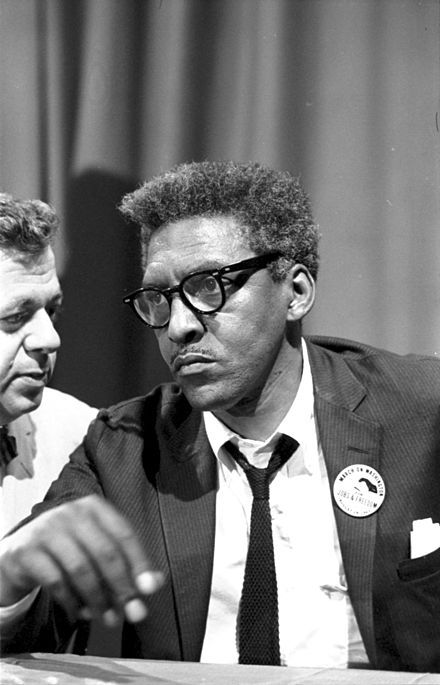
Rustin was not the most accomplished film of 2023 (one wonders how a more seasoned filmmaker like Ava DuVernay would have filmed the story; theater director George C. Wolfe has one other film, Ma Rainey’s Black Bottom under his belt). But it was arguably one of the most thought-provoking. Its images of political activism as a group effort and compelling, complex portrayal of an openly gay African American man in the 1960s whisk audiences back to pre-internet times when protest was organized with considerable effort but arguably had more impact than today’s online-driven activism. Nostalgic, cinematic comfort food or inspiration to counter myriad current injustices? In any case, if Bayard Rustin hadn’t actually existed, he would’ve needed to be invented.
********************************
Recommended: Brother Outsider: the Life of Bayard Rustin (2003), documentary by Nancy Kates and Bennett Singer. Here we see Rustin also speak at the Mall in August 1963, which for some reason the fiction film omits.
youtube
Update 1: Colman Domingo was nominated for the Best Actor - Drama Golden Globe (Cillian Murphy took home the award for his portrayal of J. Robert Oppenheimer in Christopher Nolan's eponymous biopic), BAFTA and Oscar. He is the first Afro-Latin actor and, along with Jodie Foster (Best Supporting Actress nominee for Nyad), the first out LBGTQIA* person to be nominated for playing an out LBGTQIA* role.
Update 2: American documentary filmmaker James Blue, a pioneer of participatory filmmaking with grassroots communities, directed this film about the March on Washington:
youtube
#bayard rustin#colman domingo#civil rights#film#cinema#movie#discrimination#lgbtqia#history#usa#Youtube
0 notes
Text
New Post has been published on All about business online
New Post has been published on http://yaroreviews.info/2023/03/deutsche-bank-share-slide-reignites-worries-among-investors
Deutsche Bank share slide reignites worries among investors
Getty Images
By Natalie Sherman & Simon Jack & Tom Espiner
BBC News
Sharp declines in banking shares in Europe have renewed concerns that the panic triggered by the collapse of two US banks and rushed takeover of Swiss giant Credit Suisse may not be easily contained.
Shares in Germany’s Deutsche Bank fell by 14% at one point on Friday, with other lenders also seeing big losses.
London’s FTSE 100 ended the day down 1.3%, while stock markets in Germany and France dropped even more sharply.
Falls were less severe in the US.
But shares in financial firms, including giants such as JPMorgan Chase and Goldman Sachs, weighed on the indexes, which were all trading lower around mid-day in New York.
In Europe, the banks hit by a sell-off from worried investors included Germany’s Commerzbank, which saw shares fall about 5%. France’s Societe Generale ended down about 6% while in the UK, Standard Chartered was the biggest faller, down more than 6%.
Deutsche recovered from its steepest losses but still closed more than 8% lower.
Russ Mould, investment director at AJ Bell, told the BBC that the drop in Deutsche Bank’s share price, and a sharp jump in the cost of insuring against a possible default by the bank, was “indicative of a wider loss of confidence in the banking sector”.
“There’s a gathering fear that central banks may have overdone it with interest rate increases, having left them too low for too long,” he said.
Central banks slashed interest rates during the 2008 global financial crisis and again when the pandemic hit in 2020 as part of efforts to encourage economic growth.
But over the past year or so authorities have been raising rates sharply to try to tame soaring price increases.
These rate rises have hit the value of investments that banks keep some of their money in, and contributed to the bank failures in the US.
Share prices have fallen across the sector, as high-profile investors warn the collapses are symptoms of deeper problems in the system, with other pockets of distress yet to emerge.
Higher interest rates have also raised the possibility of recession, Mr Mould said, and if that happens, “banks will generally find it pretty hard going”.
Getty Images
Central banks and governments have been trying to calm market worries.
German Chancellor Olaf Scholz defended Deutsche Bank at a news conference on Friday, noting that it had “thoroughly reorganised and modernised its business model” and was “very profitable”.
Bank of England governor Andrew Bailey also told the BBC that the UK banking system was “safe and sound”.
But mixed messages from US authorities as to whether they were prepared to guarantee all bank deposits have led to confusion and hopes that calm had been restored to the sector appear to be have been premature.
US Treasury Secretary Janet Yellen convened an unexpected Friday meeting with regulators on financial stability, while use of an emergency lending programme for banks that the US central bank created this month has increased over the past week, the Federal Reserve reported.
Bloomberg News also reported that UBS and Credit Suisse were being investigated by the US Department of Justice into whether they had helped Russian oligarchs avoid sanctions.
Meanwhile, the financial turmoil sparked by the failures has raised uncertainty about how much higher interest rates might go.
Federal Reserve chairman Jerome Powell said this week the bank may not lift borrowing costs much more, if the banking panic continues to weigh on lending and slows economic growth.
But on Friday St. Louis Fed president James Bullard, who is not currently on the rate-setting committee, said he thought the panic would subside, leading to higher rates than the roughly 5% currently expected.
Joachim Nagel, president of Germany’s Bundesbank, said still rampant inflation meant central banks should continue to raise rates.
He declined to comment on Deutsche Bank, but said market turmoil was to be expected after the failures of Silicon Valley Bank and Signature Bank in the US and the UBS takeover of Credit Suisse.
“In the weeks after such interesting events, it is often a bumpy road,” he said.
Related Topics
Deutsche Bank
FTSE 100
Stock markets
UBS
Banking
Credit Suisse
More on this story
Is this a banking crisis – how worried should I be?
3 days ago
1 note
·
View note
Text
Something broke, but the Fed's still expected to push rates higher
Federal Reserve Chairman Jerome Powell testifies during the Senate Banking, Housing, and Urban Affairs Committee hearing titled The Semiannual Monetary Policy Report to the Congress, in Hart Building on Tuesday, March 7, 2023.
Tom Williams | Cq-roll Call, Inc. | Getty Images
When the Federal Reserve starts to raise interest rates, it generally keeps doing so until something breaks, or so goes…

View On WordPress
0 notes